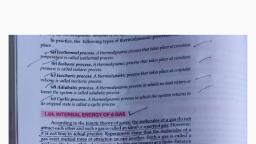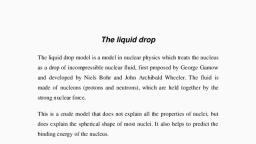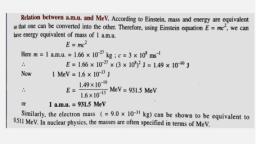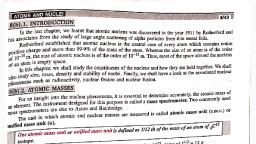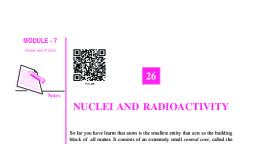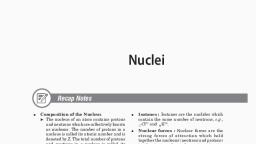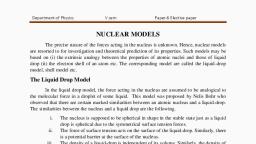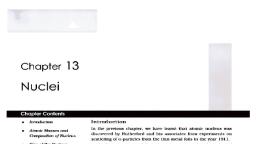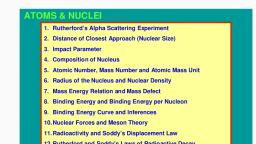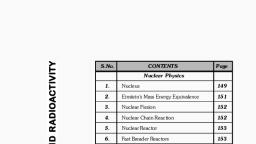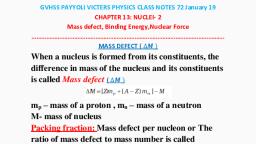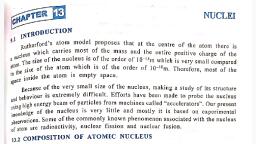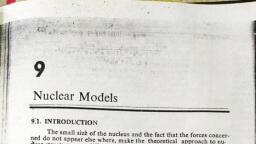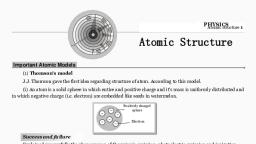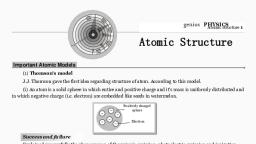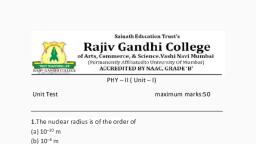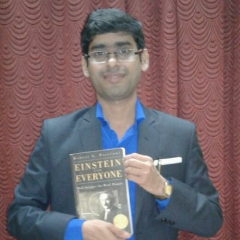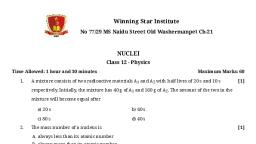Page 1 :
hold them together. In order to see, what will actually happen, let us make repulsion between two protons is ab, protons each of mass m and separated by a distance r is given by, Coulomb's repulsive force will try to blow them apart, whereas the weak, an estimate of the magnitudes of Coulomb's and gravitational forces between, metre and a number of protons and neutrons are packed inside it. Due to, electrostatic interaction between protons (positively charged), the strong Key point, Magnitude of gravitational force. The gravitational force between two attraction between a proton and an elect, gravitational force between the nucleons due to their rest masses will try to, IS not uniformly distributed inside the nucleus., 12.07. FORCE BETWEEN NUCLEONS, The nucleus of an atom is a small sphere of diameter of about 103, Inside the nucleus, electrostatic force, 1036 times the gravitational force, attraction between them., On the other hand, electrostatic force, No protons inside a nucleus., kept a certain distance apart is about 1, times the gravitational force of attracti, between them at the same distance., d., mp mp, = G, Fgram, 1
Page 2 :
forces are the only forces, then the Coulomb's repulsive force between tightly in the nucleus by a strong attractive, The extremely large magnitude of ee, static force of repulsion between pr, is the basic cause of nuclear instasliny, 1394, G= 666 x 10-11 Nm²kg², 64, Key point, Now, m = 1-67 x 10-2 kg and, STA, 6-66 X 10-11 x(1-67 ×10-2 1-86x10, Fgrav, Magnitude of Coulomb's force. The Coulomb's or electrostatic force, between two protons each having charge a and located at the same distance, r is given by, Con, thin, for, the, to, 1, 9.9, Felec =, 4 7 E, 2, =9x 10° N m2 C-2;q = 1-6 x 10-19C, 4πε,, 1, Now, cog, 9x 10° x (1-6x 1019,2 2-304 x 10, Felec =, Felec, 2-304 x 10-28, 12, Hence,, 1036., Fgrav, -64, t0 36, 1-86 x 10, Therefore, inside the nucleus, Coulomb's electrostatic repulsion, between two protòns is about 1036 times the gravitational attraction between, them., 12.08. NUCLEAR STABILITY, It follows that Coulomb's electrostatic repulsion between two protons, is extremely large as compared to the gravitational force of attraction between Key point, them.Therefore, if Coulomb's repulsive and gravitational attractive forces The extremely large magnitude of e, are the only forces operating inside the nucleus, it cannot be stable. The static force of repulsion between, stability of nucleus has been attributed to the existence of a third type of force is the basic cause of nuclear insta, inside the nucleus, called nuclear force,, The stability of a nucleus is determined by many factors. A brief account, of a few such factors is as given below :, 1. The stability of a nucleus is determined by the value of its binding, energy per nucleon". In general, higher the value of the binding energy per, nucleon, mere stable the nucleus is., 2. The stability of a nucleus is also determined by its neutron to proton, ratio. In general, for stable nuclei, neutron proton ratio should be greater, than 1., Only the lightest nuclei tend to have equal number of protons and, neutrons. As Z increases, the disruptive forces due to Coulomb's repulsion, between the protons would tend to tear off the nucleus, unless some extra, attractive forces were not brought into the nuclear structure. These extra, attractive forces are provided by neutrons, whose number exceeds the, number of protons by a larger and larger amount as Z increases., 3. Apart from the high values of binding energy per nucleon and a, proper neutron-proton ratio, the stability of a nucleon is determined by the, consideration, whether it is an even-even nucleus (even Z and even A) or an, even-odd nucleus (even Z and odd A) or odd-even nucleus (odd Z and even, A) or an odd-odd nucleus (odd Z and odd A). It is found that an even-even, nucleus is more stable, even if it has comparatively low value of binding, energy per nucleon. An even-odd or an odd-even nucleus is found to be lesser, stable, while the odd-odd nucleus is found to be least stable., 12.09. NUCLEAR FORCE, Inside the nucleus, Coulomb's repulsive force between two protons is Electrostatic repulsion would tear, about 1036 times as large as the gravitational force between them. In the nucleus apart. There has to be a loiee, presence of such a tremendous repulsive force between two protons, the bind all nucleons. Neutrons are, smalFattractive gravitational force can do little in preventing them from repelled electrostatically, but they, getting away from each other, In other words, if gravitational and electrostatic tend to drift about anywhere if not, www ort, Watch out!, Number of Number of, protons, Number of, stable nuclei, neutrons, even, 168, 55, even, even, odd, odd, odd, even, odd, Key point, *Refer to section 2.13., force., 2
Page 3 :
10 times as strong as gravitational forces., upto infinity), nuclear force is a short range force., AS strong as the Coulomb's force befween the two protons., small component of repulsive forces. The nuclear force comes into action as, 15 fermi, where the magnitude of the nuclear force becomes maximum, 42 fermi or 4-2 x 10-1 m. However, the range of nuclear force is taken as, value. Thus, unlike gravitational and electromagnetic forces (which extend, nucleons becomes negligible, when the distance between them is greater than, Containing a large number of protons is stable. It is, therefore, evident that a, 2. Nuclear forces are short range forces. The nuclear force between two, protons would tear off the nucleus.But we know that even a heavy nucleus, 1. Nuclear forces are strongest forces in nature. Nuclear forces are about, the large electro-static force of repulsion between the protons may not be able bind all nucleons, Neutrons are not, third type of force does existbetween the nucleons and it is known as nučlear Electrostatic repulsion would tear the, The exact force law obeyed by the nuclear force is not known but at a tend to drift about anywhere if not held, Properties. The nuclear forces are found to possess the following, Therefore, the relative strengths of the gravitational, Coulomb's and, This force should be basically a very strong attractive force, so that even nucleus apart. There has to be a force to, 1395, Key point, force, repelled electrostatically, but they would, m, nuclear force is estimated to be abouut 100 fimee tightly in the nucleus by a strong atdacuve, of about 10-14, distance, force., nuclear forces are, F:F:F::1:106: 1038, important properties :, tm, 3 Nuclear forces are basically strong attractive forces, but contain a, Sttractive force, when two nucleons are at a distance of about 10-14, at afnucleus). As the distance is decreased, the attractive force increases, ly and becomes maximum at a distance of about 1-5 x 10 15 If distance, decreased further, at a distance of 0-5 x 10-15m, it changes suddenly into, a repulsive force. Thus, over a large part of nucleus, the nuclear force is strong, attractive and is strong repulsive only over a small part of the nucleus. This, repulsive part saves the nucleus from collapsing.deiio, 4. Nuclear forces are saturated forces. A nucleon inside the nucleus does, not experience nuclear force due to all other pucleons. It experiences force, only due to its nearest neighbouring nucleonsJA direct consequence of this, property is that mean binding energy per núcleon for most of the nuclei has, a constant value of 8 MeV per nucleon., 5. Nuclear forces are charge independent. Inside the nucleus, the, attractive forces between two nucleons are of three types i.e. force between, a neutron and a proton (n-p), between two neutrons (n-n) and between two, protons (p-p)., Experiments indicate that the three types of forces i.e. n-p, n-n and p-p, have the same magnitude i.e., Jn-p, = n-n = p-p, Thus, inside the nucleus, the force between nucleons is not affected by, he charge of the proton and this property is known as charge independence, of nuclear forces., . Nuclear forces are spin-dependent. The force between two nucleons, ng parallel spins is greater than the force between the two nucleons, laving anti-parallel spins and hence nuclear forces are spin dependent., 7. Nuclear forces are exchange forces. The nuclear force between the two, ucleons is the result of the exchange of a mesons (, anda) between, them, ONuclear forces gre non-central forces. The force between two nucleons, called a non-central force., 12.10. MASS-ENERGY EQUIVALENCE
Page 4 :
electron, proton and neutron are respectively, than the total mass of the constituent nucleons. In other words, if a certain, number of neutrons and protons are brought together to form a nucleus, the, are held inside the nucleus by the strong attractive forces, called nuclear, each other, it is worthwhile to investigate as to how a nucleus is formed from, forces. Since the free protons would exert a very strong force of repulsion on, In general, the nucleus of an atom is stable. The protons and neutrons, m=0:511 MeV, m, = 938 279 MeV and m,,= 939-573 MeV, Note. It can be calculated that the energy equivalents of the mass of an, 2.12. MASS DEFECT AND BINDING ENERGYA, T-602 x 10-13tter, 1 a.m.u. = 931-5 MeV, 1.602 A10, 13, or, %3D, p., %3D, free protons and neutrons., Pass defect. It is found that the mass of a stable nucleus is always less, s of the nucleons forming the nucleus decreases or defects., The difference between the sum of the masses of the nucleons constituting a nucleus, nd the rest mass of the nucleus is known as mass defect. It is denoted by A, Let us calculate the mass defect in case of the nucleus of an atom, The nucleus of such an atom contains Z protons and (A-Z) neutrons., Therefore,, mass of the constituting nucleons =Zm, + (A- Z) m, If mGX), is given by, is mass of the nucleus of the atom „X, then the mass defect The jargon, Th mass of the a, .(2.06) chemical symbe, atomic number, and that of itsn, Am [Z m, + (A-Z) m,] –m(GX^), d., The mass defect can also be expressed in another form as explained, below :, Adding and subtracting the mass of Z electrons i.e. Z m on the R.H.S., of equation (2.06), we have, e, before 1960, atomic mass unit was defined as 1/16th of mass of an O16 atom., on this basis, the atomic masses of many elements differ considerably from the, integral multiples of the mass of hydrogen atom., 4
Page 5 :
mass defect is used in binding the nucleons and is called binding energy of nucleus may be termed as the work, If A m is mass defect of a nucleus, then according to Einstein's mass- hydrogen nucleus is zero. It is beca, accordance with Einstein's mass-energy relation), The energy equivalent to nuclear force. The binding energy o, decrease in mass of the nucleons is released as equivalent energy (in Nucleons are bound together by the s, the nucleus. In order to break the nucleus or to completely separate the against the binding force to pull, no work need to be done to overcome, strong nuclear force is not involved and, there is only one nucleon. Therefo, Mass defect and hence binding energy, PHYSICS (CLA, Am [Z m, + (A-Z) m, + Zm-m GX^)-Zm,, IZ (m, +m)+(A-Z) m,- (mX^) + Zm,], 1398, " , m(H'), mass of hydrogen atom and, mass of the atom XA, Now,, ...(2.07), Therefore, Am 1Z m (,H) + (A-Z) m,1-m, Binding energy. When a nucleus is formed from the free nucleons, the Key point, nucleons apart., nucleons from each other,, Thus the binding energu of a nucleus may be defined as the energy equivalent, to the mass dect of the nucleus., t may be measured as the work required to be done to separate the, nucleons an infinite distance apart, so that they no longer interact with Watch out !, each other., equal amount of work has to be done,, energy relation, binding energy of the nucleus Am c (in joule), Here, mass defect Am has to be measured in kilogram. In case, mass, defect is measud in a.m.u., then binding energy of the nucleus, = Am x 931-5 (in MeV), The binding energy of a nucleus may also be'expressed in terms of, masses of protons, neutrons and the nucleus as explained below:, From the equation (2.06), we have, binding energy [[Zm, +(A-Z) m,)- mGX^)1× 931-5, Watch out!, .(2.08), Binding energy is sometimes considemnd, negative quantity, since it is an eoer, deficit !, Here, mX^) is mass of the nucleus of the atomX., Also, using equation (2.07), we have, binding energy = [[ZN,H)+ (A- m)– mX^)1x 931-5, .(2.09), Here, m (,F') and m (X^) represent the masses of hydrogenatom, (GH) and the atom, Binding energy per nucleon. The binding energy per nucleon is the average, energy required to extract one nucleon from the nucleus. It is obtained by dividing, the binding energy of the nucleus by the number of nucleons it contains., binding energy, A, .(2.10), Thus, binding energy per nucleon D, It may be pointed out that the binding energy per nucleon of a nucleus, is more important than the total binding energy of the nucleus. The higher, value of the binding energy per nucleon indicates comparatively greater, stability of the nucleus., Packing fraction. The packing fraction of a nucleus is defined as the mass, defect per nucleon of the nucleus., mass defect, Thus,, packing fraction D, ..(2.11), A, Watch out !, The packing fraction of anucleus is closely related to its binding energy By definition, the value of packing i, per nucleon. For nuclei having A <20, the value of packing fraction is positive. for O16 is zero., With the increase in mass number A, its value becomes negative attaining a, minimum value and then again becomes positive for A> 1801, Window, To Formula the masses of a-particle, proton and neutron are, Problem 2.04. Find out the binding energy per, nucleon of an a-particle in MeV. It is given that, respectively 4:00150 a.m.u.,1-00728 a.m.u. and, 1-00867 a.m.u., Sol. An a-particle i.e. nucleus of helium, consists of, two protons and two neutrons., (I.S.C.E. 1998,1994)
